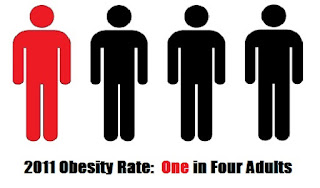The rate of obesity* has nearly doubled from about 15 percent of the population to more than 26 percent in less than two decades (1990-2010). Unfortunately, due to new survey methodology, the 2011 data released by CDC is not comparable with prior years.
In Colorado, which has the nation’s lowest rate (21%), more than one out of five adults are obese. Hawaii and Massachusetts are the only other states with rates below 23 percent.
The nation’s highest rates of obesity are in the southeast, with Mississippi (35%) topping the charts. Neighboring Alabama and Louisiana also exceed thirty percent.
So why are we getting fat?
There are a variety of factors at play in the rising obesity epidemic. Many sources show a correlation between obesity and commuting. The Federal Reserve and the USDA suggest that increased food consumption, particularly fast food, is the primary driver expanding America's waistlines.
New research, from Pennington Biomedical Research Center at Louisiana State University, digs into another trend - our economy - to understand the obesity epidemic. Using data on occupational patterns since the 1960s, coupled with weight data, and energy expenditure (i.e. calories burned) per day per occupation, they come to a startling conclusion: modern jobs make us fat. Specifically
"In the early 1960's almost half the jobs in private industry in the U.S. required at least moderate intensity physical activity whereas now less than 20% demand this level of energy expenditure. Since 1960 the estimated mean daily energy expenditure due to work related physical activity has dropped by more than 100 calories in both women and men."Research from the Mayo Clinic, American Cancer Society, and have come to a similar conclusion - sedentary behavior leads to obesity. So the advent of desk jobs that require sitting for long periods of time may be a primary cause of rising rates of obesity.
One conclusion is certain, whatever the cause (or, more likely, causes) of obesity, the cost is too high to be ignored. Obesity can put people at higher risk for health problems including heart disease, diabetes, certain types of cancer (including breast and colon), high blood pressure, stroke, and other problems.
In addition to the health risk, these obesity-related diseases carry a hefty price tag. Healthcare costs for obese Americans were $1,429 higher than for persons of normal weight in 2008, according to research published in the journal Health Affairs. Today obesity-related diseases cost the nation an estimated $190 billion annually.
*According to the CDC, obesity is “defined as a Body Mass Index (BMI) of 30 or greater.BMI is calculated from a person's weight and height and provides a reasonable indicator of body fatness and weight categories that may lead to health problems. Obesity is a major risk factor for cardiovascular disease, certain types of cancer, and type 2 diabetes.”

No comments:
Post a Comment
your insights?